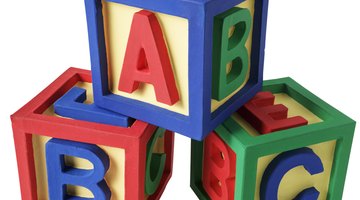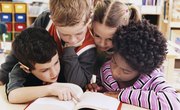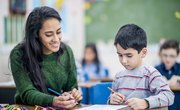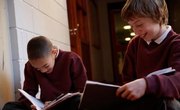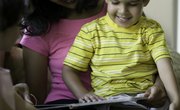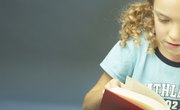The Four Blocks Literacy Framework was developed in 1989 by first-grade teachers Patricia Cunningham and Dorothy Hall. Since then, it has been widely adopted as a balanced literacy program for use in kindergarten through fifth grade. Variations on the model include Building Blocks, meant especially for kindergarten students, and Big Blocks, intended for students in third through fifth grades. The framework consists of four sections, called blocks, which include Guided Reading, Writing, Working with Words and Self-Selected Reading. Each block is meant to be addressed daily.
Guided Reading
The guided reading block should be 30 to 40 minutes in length. The goals of this block are to build background knowledge, vocabulary and comprehension skills through before, during and after reading activities. The block generally begins with teacher-led discussion to review concepts or activate prior knowledge. Students are presented with material both at reading level and below reading level. Comprehension skills are a main focus and are addressed through small multilevel groupings such as book club groups.
Writing
Each writing block is intended to be 40 minutes long. The goals of the writing block are to enhance students' independent writing skills as well as expressive language skills as they share the pieces they have written. The block begins with a short five- to 10-minute mini-lesson that focuses on one aspect of the writing or editing process. Students then write on self-selected topics and conference with the teacher. Sharing is the final component of this block. Student should have ample opportunity to share the pieces they are working on and receive peer feedback.
Self-Selected Reading
The self-selected reading block is a 30-minute daily block of time that consists of a teacher read-aloud and short discussion followed by independent conferences with the teacher. Goals of this block are to improve book selection skills, reading comprehension and decoding. During the independent conferences, teachers address individual student needs. This process is the most powerful part of the self-selected reading block, as it gives each child opportunities to work at her particular skills level with the teacher's guidance.
Working with Words
The working with words block should be another 30-minute portion of the classroom literacy block. The goals of this block are for students to increase recognition and fluency of high-frequency words and to improve spelling and decoding skills. Components of the block are word wall activities, where students are introduced and gain practice with pre-selected words, and decoding and spelling activities. Decoding and spelling activities consist of rhyming activities, making and sorting word families, and using spelling patterns and context clues to decode unknown words.
Related Articles
References
Writer Bio
Alicia Anthony is a seasoned educator with more than 10 years classroom experience in the K-12 setting. She holds a Master of Education in literacy curriculum and instruction and a Bachelor of Arts in communications. She is completing a Master of Fine Arts degree in creative writing: fiction, and working on a novel.

